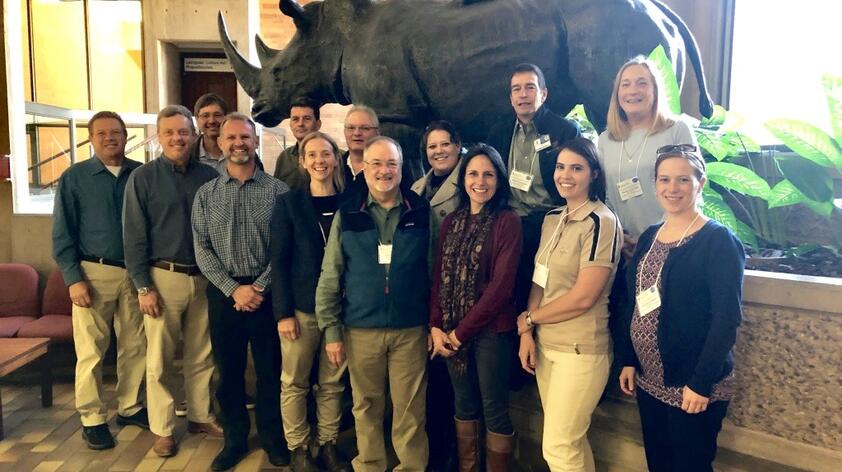
Building an international team to save the Northern White Rhino (NWR)
In early 2016, just three months after six female southern white rhinos (SWR) arrived from South Africa to form the nucleus of our Rhino Rescue Center (RRC) herd, an international panel of experts met at the Beckman Center for Conservation Research.
The first order of business was to perform complete medical and reproductive assessments of each of our new rhinos. A team of SDZG scientists, veterinarians and wildlife care specialists was joined by rhino and equine consultants from several US universities and zoos, as well as researchers and veterinarians from Germany and South Africa. All six RRC females were declared healthy and reproductively sound – a great start for the NWR Initiative!
Continued discussions with the South African delegate and other associates in that country convinced us that their knowledge of wild and semi-free ranging white rhinos was essential to our common goal of saving both southern and northern subspecies. We were excited to meet fellow conservationists in the country holding the largest number of white rhinos, and we set off on the first NWR team trip. I was fortunate to travel with Randy Rieches (Director of Conservation Husbandry Science at the Safari Park), Stacey Johnson (Corporate Director of Conservation & Research), and Oliver Ryder (Director of Conservation Genetics). We visited colleagues at the National Zoological Gardens Biobank at our sister zoo in Pretoria, the Institute of Rhino Cryogenics, EmbryoPlus, some private rhino-holding ranches, RhODIS (Rhino DNA Index System) at the University of Pretoria, and the veterinary school in Onderstepoort.
We invited faculty and students at the vet school to a talk by Dr. Ryder describing our plan to use advanced genetic techniques and assisted reproductive technology to save the NWR. A reception following the seminar extended through dinner, and as we got to know one another we started to envision an allied research strategy. We were hesitant to leave our new friends at the end of a long week but returned to San Diego buoyed by the prospect of working together to save white rhinos.
The dialog initiated during that first trip continued and expanded over the next two years, leading to a second trip to South Africa in 2018, this time with a very specific agenda. With the help of Christina Rogers (NWR Conservation Program Manager) and Onderstepoort faculty, we hosted a meeting to explore mutual interests and collaboration in rhino conservation research focused on reproduction.
Formal presentations covered topics including genetic histories of African rhinos, rhino herd management on large private reserves and in zoological institutions, artificial reproduction and oocyte retrieval, poaching in national parks, and more. The next day representatives of several organizations (listed in the photo caption) declared their commitment to work together and the International Rhino Reproduction Collaborative (IRRC) was born. It was a thrilling moment for us and a significant step for rhino conservation!
In the two years following the creation of the collaborative, we continued to strengthen the IRRC network by sharing research data, lab protocols, literature, problems, and successes. We held regular virtual meetings and planned our next gathering in South Africa. This time the SDZG team included Senior Research Associate Carly Young from the Reproductive Sciences team and meetings were replaced by field and lab work. The next blog in this series will describe the advances made during this recent trip.
Although most of our days were very long, the camaraderie and open sharing of information made the time fly by, and all too soon we were back in San Diego putting into practice what we learned. To be honest, though, Carly and I did take an extra day to go on safari in Pilanesburg where we saw both black and white rhinos along with an array of other beautiful African species in the wild. What a great way to end our adventure.
Photo above: The newly formed International Rhino Reproduction Collaborative at the University of Pretoria in 2018. Members include San Diego Zoo Global, University of Pretoria, EmbryoPlus, Buffalo Dream Ranch, Institute for Rhino Cryogenetics, South African National Parks and Geolifes. Photo credit: Martin Schulman on behalf of the University of Pretoria.













